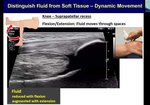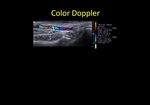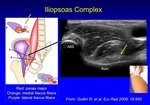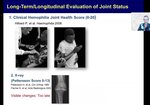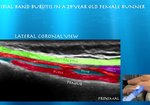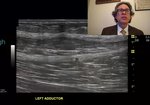
Video Player is loading.
Current Time 0:00
/
Duration 0:00
Loaded: 0%
0:00
Stream Type LIVE
1x
- 0.5x
- 0.75x
- 1x, selected
- 1.25x
- 1.5x
- 1.75x
- 2x
- Chapters
- descriptions off, selected
- captions settings, opens captions settings dialog
- captions off, selected
This is a modal window.
Beginning of dialog window. Escape will cancel and close the window.
End of dialog window.
10 seconds
Playback speed
This is a modal window. This modal can be closed by pressing the Escape key or activating the close button.
Calf Tear or Ruptured Baker's Cyst? How to Differentiate Them on Ultrasound
By
Learn MSK Sono
FEATURING
Jamie Bie, RMSKS, RVT, RDMS
By
Learn MSK Sono
FEATURING
Jamie Bie, RMSKS, RVT, RDMS
65 views
July 4, 2023
Do you know how to differentiate a calf tear from a ruptured Baker’s cyst on ...
read more ↘ ultrasound?
The simplest way to tell the difference in the sonographic appearance of these two findings within the calf is that the fluid collection from a ruptured Baker’s cyst typically lies superficial to the gastrocnemius muscle in the subcutaneous fat layer, whereas a calf tear lies deep to the fascia that lies between the fat and muscle layer. It is possible for a Baker’s cyst to extend into the muscle itself, but it is very rare.
Sometimes you may be able to track the fluid from the calf back to the cyst cavity in the popliteal fossa by using extended field of view if the cyst has only partially ruptured, but it is not possible when the cyst has completely ruptured and all of the fluid from the cyst has already leaked into the calf.
You cannot judge by the echotexture of the fluid collection itself because either may appear simple and anechoic or may contain internal echoes from hemorrhage.
Clinically, a calf tear usually presents as a sudden pain and pop in the calf while a ruptured baker's cyst often causes pain in the posterior knee. Both are usually associated with physical activity and may cause calf swelling.
↖ read less
read more ↘ ultrasound?
The simplest way to tell the difference in the sonographic appearance of these two findings within the calf is that the fluid collection from a ruptured Baker’s cyst typically lies superficial to the gastrocnemius muscle in the subcutaneous fat layer, whereas a calf tear lies deep to the fascia that lies between the fat and muscle layer. It is possible for a Baker’s cyst to extend into the muscle itself, but it is very rare.
Sometimes you may be able to track the fluid from the calf back to the cyst cavity in the popliteal fossa by using extended field of view if the cyst has only partially ruptured, but it is not possible when the cyst has completely ruptured and all of the fluid from the cyst has already leaked into the calf.
You cannot judge by the echotexture of the fluid collection itself because either may appear simple and anechoic or may contain internal echoes from hemorrhage.
Clinically, a calf tear usually presents as a sudden pain and pop in the calf while a ruptured baker's cyst often causes pain in the posterior knee. Both are usually associated with physical activity and may cause calf swelling.
↖ read less
Comments 0
Login to view comments.
Click here to Login






